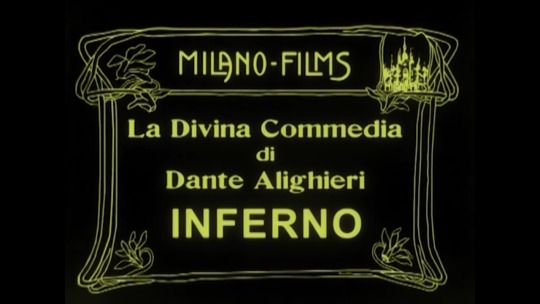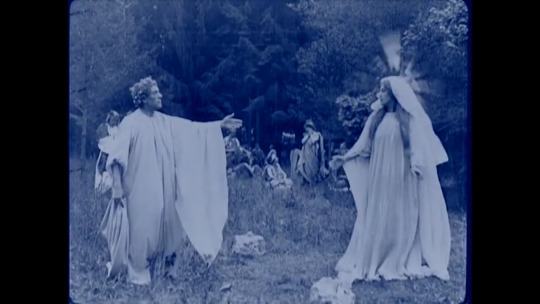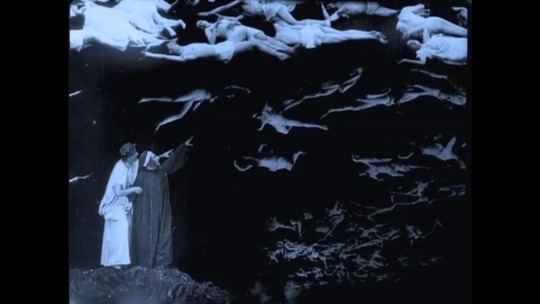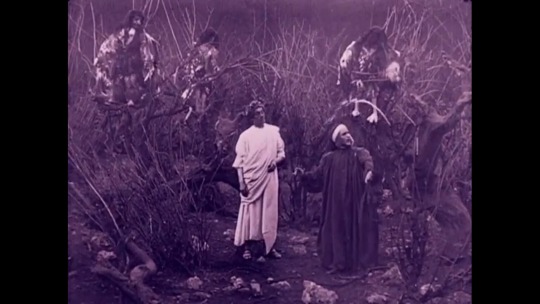#just as virgil can only lead dante to the summit of purgatory
Explore tagged Tumblr posts
Text

#have your periodic reminding of the divine comedy#get teensy drunk#realise that what truly upsets you about ttc is the fact that it frames the doctor as the dante figure#after decades of being one of the very few virgil type protagonists in mass culture#it's the companions that are dantes which is why they tend to finish their journeys as not just better than they were#but better than the doctor#just as virgil can only lead dante to the summit of purgatory#yes there's the whole christian soteriplogy in the mix but. look at the structure#ranting in the tags#ranting so maybe i'll finally sleep
1 note
·
View note
Text
L'Inferno (1911) Movie Review!
As promised, we're gonna be celebrating this Spooky Season with a Devilman Crybaby headcanon! In order to fully express my HC, I will be reviewing icons of horror cinema and literature that helped contribute to many of the themes and ideas that are prevalent in Go Nagai's original manga. So, without further ado, let us descend into the Blind World. Put all fear and cowardice aside. I will be your guide through this eternal place, where you shall hear the shrieks and see the tormented spirits who all bewail the second death.

And how appropriate? Because our first film is the 1911 adaptation of The Inferno by Dante Alighieri. I suppose it's only right to begin this saga of horror films with one of the first horror films ever made. Okay, "first horror film" is actually debatable, so keep in mind that I said "ONE of the first." In any case, it remains one of the most important landmarks in horror cinema.
"Stopped, in the middle of what we call life,
I looked up and saw no sky, but rather a dense cage of leaf and tree and twig,
For I was lost."
The film opens as the iconic poem does. Dante Alighieri is a middle-aged man who finds himself lost in a dark, gloomy forest. This opening of the story always had a way of making me feel somewhat lonely and isolated. In my interpretation, I always saw this forest as being symbolic of how Dante felt after the death of Beatrice. Allow me to explain...
For those who don't know, Dante met a young girl named Beatrice when they were both nine years old. The young boy immediately fell in love with her, even though they hardly interacted. Despite their lives continuing in separate directions, Beatrice had always and forever held a special place in Dante's heart. When he received word that she had died, Dante was absolutely devastated. He felt that she deserved to be immortalized in what he intended to be his magnum opus; The Divine Comedy.
I believe that this opening to the Inferno is actually Dante going to a journey to find Beatrice so that he could say goodbye to her. Along the way, he got lost, both literally and spiritually. That, in my opinion, is what this forest symbolizes. In many ways, this opening kind of reminds of the opening to Silent Hill 2, just from how dismal it is.
Having said all that, I think the film does a very poor job of conveying those emotions. Sadly, I just don't feel any of the despair that was present in the original poem. He just wanders around for a few seconds, then steps out into a clearing. But don't worry! As soon as Dante steps into the clearing, the film IMMEDIATELY gets better. Upon entering this clearing, Dante finds himself at the base of, what I believe to be, Mount Purgatory. I can only assume that's where he is, because the gates of Hell are at its base, and Dante seems to suggest the gates of heaven are at its summit, just like Purgatory. Unfortunately, his path is blocked by three ravenous beasts: a leopard, a lion, and a she-wolf, all representing different Earthly sins. He runs back the way he came, before being rescued by a strange apparition. It's here that the film begins to remind us all of why the original poem is regarded as a self-insert fanfic...
Upon introducing himself to the apparition, Dante learns that it is the actually the ghost of Virgil, author of the Aeneid. The significance of Virgil being in the story is that he was Dante's favorite poet of all time, and Dante always longed to meet and interact with him. It's literally a self-insert fanfic of Dante meeting and interacting with all of his inspirations. It's honestly a mystery to me why I love The Inferno so much, because it's everything I hate! It's a Catholic's fanfic about why he sees himself and his friends as morally superior and why everyone he ever disagreed with is going to Hell. Somehow, in spite of all that, I still love it.
So why did Virgil even decide to help Dante in the first place? Well, remember when I talked about Beatrice dying? It turns out, she descended from Heaven into Hell to ask him for help, because she knew how important he was to Dante. She tasked Virgil with being Dante's guide, after seeing that he has gone astray.
This is where the film's innovation starts to take shape. Beatrice has often been drawn as having a halo around her head. The problem is, how do you show that in a film made in 1911? The effect was strikingly realized with, what I assume to be, spinning rods covered in reflective material. I can only guess this is how it was done, but it appears right to me, because that's how a similar effect was created for the lightsabers in the original Star Wars. It looks like the rods were placed behind the actress, so that the rig couldn't be seen, making it appear as if the light was emanating from her head. This scene also displays an early appearance of wire work on film. In those days, that shit wasn't easy. It was even harder to hide the effect, which this film does fairly well.

So, Virgil explains to Dante that he must take him on a pilgrimage through the three different stages of the afterlife. To be perfectly honest, I never understood why. Maybe I'm just an idiot with little to no reading comprehension. It's also a factor that I haven't read parts II and III of the Divine Comedy, so maybe it's elaborated better in there. From what I gathered, since Dante is going on a journey to find the literal Stairway to Heaven (Led Zeppelin intensifies) Virgil needs to take him to Hell and Purgatory, so he can face his sins and better appreciate Paradise. And thus, Virgil's pilgrimage to lead Dante through the Afterlife begins!
"Through me, the way to the City of Woe
Through me, the way to everlasting pain
Through me, the way among the people lost
Divine Power made me
Eternal I endure
Abandon Hope, all ye who enter here"
That is the inscription above the Gates of Hell. It is here, that Dante is already planning on turning back. Virgil literally tells him to stop being a pussy, and I was satisfied. Once they enter the gates, it becomes apparent to the viewer, if it hasn't already, that this isn't just an adaptation of Dante's work. This film is actually a cinematic translation of the ICONIC illustrations by Gustave Dore that were created in the middle of the 19th century. So much care and detail was put into recreating his AMAZING artwork, that many consider to be his magnum opus. This film was basically the Zack Snyder's Watchmen of its day!


Those familiar with the story will recognize this iconic scene that is being recreated onscreen. Dante and Virgil have come to the shores of Acharon, where the souls of the damned board Charon's vessel to be taken before Judge Minos, who lives in Limbo.
Speaking of Limbo, that is the first spiral of Hell Dante visits. This is where good people who weren't Christians come to face eternity. Their punishment is meant to be the denial of Paradise, but if you ask me, it doesn't seem so bad. Apparently Dante felt the same way, because this is where he meets his other great inspirations, such as Homer and Ovid! The poets all enjoy their visit together before Virgil must take Dante on his way. This is honestly the part that makes me cringe the most. Nothing reeks of self-insert fanfic more than meeting your idols and being greatly respected by all them. This is exactly why I abandoned my Silent Hill fanfic.
Anyway, Minos's throne lies at the lower boarder of Limbo. The king himself appears as a giant naked bearded man with a snake tail. The tail is used to determine the punishment of sinners by wrapping around Minos's own neck multiple times. However many times the tail coils determines which spiral the sinner is sent to.
And here we get to my favorite scene in the whole film: Lust! This spiral perfectly displays the true innovation of special effects. In this spiral, sinners are punished by being caught in a tumultuous whirlwind. The wind symbolizes the tumultuous feelings that arise between lustful lovers. It's one of Dore's best illustrations, and it blows my mind that the filmmakers were able to recreate it so well!


Our two pilgrims move onward to the Spiral of Gluttony, where we come across Cerberus. He guards this spiral, but Virgil subdues him by throwing a clump of dirt in his face (still more respectful than Lore Olympus). Honestly, Gluttony is nothing to write home about. It's just a raining landscape with people laying in the mud. Still, I have to give credit for the meticulous recreation of Dore's art!
Down in Greed, who else do we find guarding this spiral, other than Plutus?
SIDE NOTE: I've read a very strange "translation" of his dialogue. The original line reads, "Pape Satan, Pape Satan, allepe!" Strangely, no one seems to agree on what exactly this means, so most translations are different. Particularly, in the case of Douglas Neff, he translates "Pape" to "Papa," which is strange because "Pape" means "Pope" in Itialian. Then, he changes "allepe" to "you are my king." Let's also not forget that Plutus was also occasionally used as an epithet for Hades and/or Pluto. This means Douglas Neff literally wrote Hades to say, "Daddy Satan, I worship you" (still more respectful than Lore Olympus)!
In the Spiral of Greed, the sinners are forced push heavy sacks of gold around for eternity. Once again, this scene is nothing special, but still an admirable recreation of the illustrations that inspired it.
The next scene, however, shows off more of the innovative talent that makes this film so amazing! Virgil and Dante move on to the Spiral of Anger, where the sinners are punished by being submerged in the black sludge of the River Styx. The only way across is by boat. This is where Phlegyas comes in. The two poets stand by a giant tower which they use to signal for passage to the City of Dis. Along the way, the boat is stopped by Dante's political and intellectual rival, Philipo Argenti. It's here that one realizes just how petty Dante truly was. "Oh, I disagree with you politically. Therefore, you deserve to drown in sludge for all eternity!" He sounds like people I used to know. Hell, he sounds like me in high school!
All while this is going on, we see an amazing special effect of a double exposure of Dis in the background. It's an amazing miniature of the city's outer wall, optically printed to take up the entire top half of the screen.

Finally, they make it to the other side of the river, where we actually get a cameo by Hades' and Persephone's children! No, not Zagareus, Makaria, and Melinoe. None of those people were Hades' and Persephone's children. I'm actually referring to the Erinyes (also known as, the Furies). They block Dante's entrance to the city's gates, so Virgil calls upon the aid of an Archangel to rid them of the Furies. It is here that Dante asserts the superiority of Christianity over the Hellenistic faith (still more respectful than Lore Olympus).
Within the City of Dis, Hell begins to look more like how we always imagined, with fire and brimstone. In the Spiral of Heresy, sinners are stuffed into eternally burning ovens embedded in the ground.
Beyond that is the only omitted sequence from the poem. In the original Divine Comedy, the Spiral of Violence is originally guarded by the Minotaur! Beyond that are sinners, stewed in a boiling river of blood (The Phlegethon). On the banks, we see a heard of Centaurs practicing their archery on them. These are the individuals who were violent towards other people. In order to cross the river of blood, Dante and Virgil must ride on the back of one of the centaurs. You know, having heard of centaurs' notorious reputation for being horrible rapists, it makes me concerned for the sake of our Pilgrims. Maybe they didn't include this in the film because they couldn't figure out how to make a centaur?
On the other side of the Phlegethon, Violence continues into the suicide forest (*Logan Paul reference here*). Here is where sinners, who were violent against themselves, are punished. Once judged to this spiral, they grow into trees. The symbolism being that trees are a symbol of life, of which these sinners have deprived themselves. I'm surprised this scene isn't more controversial. After all, seeing as how seriously mental health has been taken recently, it's fucking awful to tell someone they're going to Hell for committing suicide! As a peice of horrific imagery, I love this scene, but knowing that Dante actually believed this makes me despise it.
In addition to being a horrifying concept, this scene also includes one of the first instances of bloodshed in a horror film. Virgil explains to Dante that he can speak with the sinners if he breaks one of their branches. When he does, blood sprays out of the tree like a drinking fountain!

After a brief conversation with the sinners, Dante moves on to the final section of violence, where people were violent against God. Here the sinners are punished in a desert that perpetually rains fire.
Now, not every special effect in this film is good. Because when Dante rides down to the eighth spiral on Geryon's back, it is such a stiff, unnatural, badly puppeteered marrianet that they couldn't even keep stable for the shot!
"There is a place in Hell called the Malebolge..."
Now, we get to my favorite part of the whole poem: The Spiral of Fraud. Here the deceivers are punished in a myriad of ways, depending on how they lied to others.
In the first Spiral of the Malebolge, those who pander towards others are mercilessly whipped for all eternity. This marks the first appearance of the classic image of the winged demons that we all know and love.
In the second spiral, the flattererers bathe in a stagnant pond of their own feces and vomit. This symbolizes the value of the words that they spew at other people. I think this might be where the expression, "You're full of shit," came from. Think about it; you say that to people whom you think are lying to you, and this is in the Spiral of Fraud.
Incidentally, this punishment was referenced in a Turkish horror film called Baskin -- a film about a small group of off-duty police officers who crash their car and wake up in Hell. In that film, the main characters realize they're in Hell when they find demon raping someone, while shoving her face in a bowl of her own face and vomit. Baskin is not a part of this HC, so I'll have to talk about it later. For now, I'll just say it's one of the best horror films I've ever seen!
In the third spiral, those who joined the Catholic Church for their own personal gain are buried head first, with their feet sticking out in the air.
In the fourth spiral, fortune tellers have their heads turned backwards. This prevents them from looking forward, symbolizing their attempts to see into the future.
In the fifth spiral, the sinners are repeatedly dipped in boiling tar. This scene is especially interesting because it shows that the demons we see aren't actually monsters. They're just creatures doing their jobs, punishing sinners. In fact one of the demons named Malecoda assigns a group of demons to help escort Dante and Virgil through the rest of the Malebolge. That, unfortunately, doesn't work out, however, because the demons are distracted by a sinner trying to escape, so Dante and Virgil move on alone. What's also unfortunate, is that other demons, who assume that Virgil and Dante are also sinners trying to escape, chase them into the next spiral. Luckily, each demon is confined to their own spiral, so they can't keep chasing them.
In the sixth spiral, the hypocrites are forced to wear robes made of solid gold. They also find Caiaphas nailed to the ground. As someone who has Jesus Christ Superstar on his top three list of favorite albums, I was happy to see Caiaphas get referenced.
In the seventh spiral, the thieves are bound by snakes, whose venom causes them to burn to ashes. One thief in particular gets attacked by a giant lizard that makes him into a lizardman (someone tell Alex Jones).
In the eighth spiral, the false advisors are eternally engulfed in flames.
In the ninth spiral, the sowers of discord are viciously mutilated. My favorite part about this scene is that it's one of the first instances of gore in a horror movie. The prophet Muhammad has been cloven from his belly to his throat with his guts spilling out all over the place. That's right! Muhammad is depicted in the Inferno. Not only that, but Gustave Dore drew him. Damn. Dante has no chill. Hey, the founder of the most homophobic religion in the world rots in eternal Hell? I'm not complaining! This kinda makes up for the portrayal of suicide victims.

In the tenth spiral, the falsifiers are punished with enternal leprosy.
At last, we make it to the Spiral of Treachery, at the center of the earth. Here, the traitors are frozen within the Lake Cocytus.
"Lo! Dis Himself!
Emperor of the Kingdom of Woe"
Finally, at the climax of this horrific epic, we see Satan, and it's not what you're expecting! He is in the very center of the lake, frozen up to his waist in ice, and forced to eat the three greatest traitors of all. His body is covered in course fur, and he has three heads and six wings. Satan's appearance in this story is disarming and almost pathetic in a way. You'd imagine Satan to be this fearsome king, but he's just shown to be suffering like everyone else. It's kind of sad, really.

The film ends with Dante and Virgil climbing down Satan's leg fur and ending up at the base of Mount Purgatory.
L'Inferno is one of the first true masterpieces of horror! It's hard to believe that this movie is almost 110 years old! Just think of how it would have been to see it in theaters for the first time when it was new. We owe it to this film for proving the language of Cinema could be used to tell the most epic stories possibly conceived.
You can watch the film for yourself here:https://youtu.be/cMUPbPOGPdM
youtube
Now, you're probably thinking, "What the Sam Fuck does any of this have to do with Devilman Crybaby?" Well, for starters, in Go Nagai's original manga, the character Asuka Ryo implies that Dante's Divine Comedy might have been based on a true story. This is futher validated when the demon Xenon appears and bears a strong resemblance to Dante's description of Satan. But beyond the surface-level details, let's discuss some of the deeper implications of what Hell actually is. Within this headcanon, the Afterlife is an entirely separate dimension, occupying the same space as our Earth, but invisible to our eyes. There is a way, however, to see and explore this separate dimension. You see, when different dimensions intersect at certain angles, they sometimes leave gaps through which we can come through and cross over to the other dimension. It was through one of these gaps that Virgil was able to find Dante. These angles and gaps between dimensions will be further explored in a later film.
#dante's inferno#dante's divine comedy#l'inferno#devilman crybaby#devilman crybaby headcanon#Youtube
11 notes
·
View notes